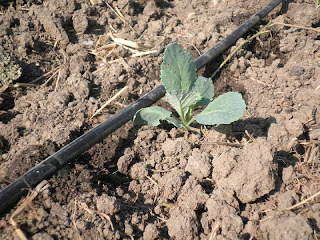EGGS This week only, we have enough eggs to add to the shares. Our hens have been busy fertilizing, weeding and eating bugs for us, when they aren’t sitting in the coop laying their healthy and colorful eggs. (eggs will be offered on the bulk list for the next two weeks. Egg shares start the first week of the regular season in three weeks.)
LETTUCE From the high tunnel, butterhead or red leaf varieties.
FRISEE ENDIVE Add to your lettuce for a frilly salad.
SPINACH We may be out of spinach after this week, it had a long run from its original seeding in September 2015.
GAILAN Also planted back in September, broccoli’s more slender cousin.
ARUGULA OR SWISS CHARD More greens from the high tunnel.
CARROTS From cold storage of the fall 2015 crop.
POTATOES Ditto on these.
HERB CHOICE garlic chives and/or tarragon
NEXT WEEK: Lettuce, green onions, hakurei turnips, radishes, and bok choy
FARM REPORT:
Welcome to the first week of the CSA! The harvest has begun just in time for Earth Day. Organic farming and community participation is what sustainability is all about. Thank you for caring about your Mother Earth!
The planting of the Spring crops is all but complete. The fields are full of peas, potatoes, onions, broccoli, cabbage, kale, chard, carrots, beets, spinach, leeks and loads of lettuce. Here we are last week putting the finishing touches on the leek planting.
The rain has given us a temporary break from planting work. Instead we filled our time giving the packing room and wash area a good Spring cleaning. We adhere to and train our crew in good food safety practices. This includes cleaning and sanitizing all of the crates and tools that we use for harvest. It is a big task, but well worth the effort.
Up until two days ago, the fields were very dry. Dry weather has its pros and cons. Last year during the torrential rains I told more than one person that it is much easier to bring water to the plants than to take it away.
Other pros of dry weather: it was dry enough to kill lots of weeds! Here’s me and the cultivating tractor, our Allis Chalmers G, getting things tidy.
However, there is a big con of dry weather: it was necessary to walk out irrigation tape in April, which is not always necessary but was very necessary two weeks ago. This takes time, but was totally worth it. All of our transplants look amazing after a nice drink from the pond followed by a good bath from the sky.
So, I’m sticking to my assertion that a dry year is better than a way-too-wet one. Although this week’s rain was tremendous and impossible to duplicate. Thank your Mother Earth!









